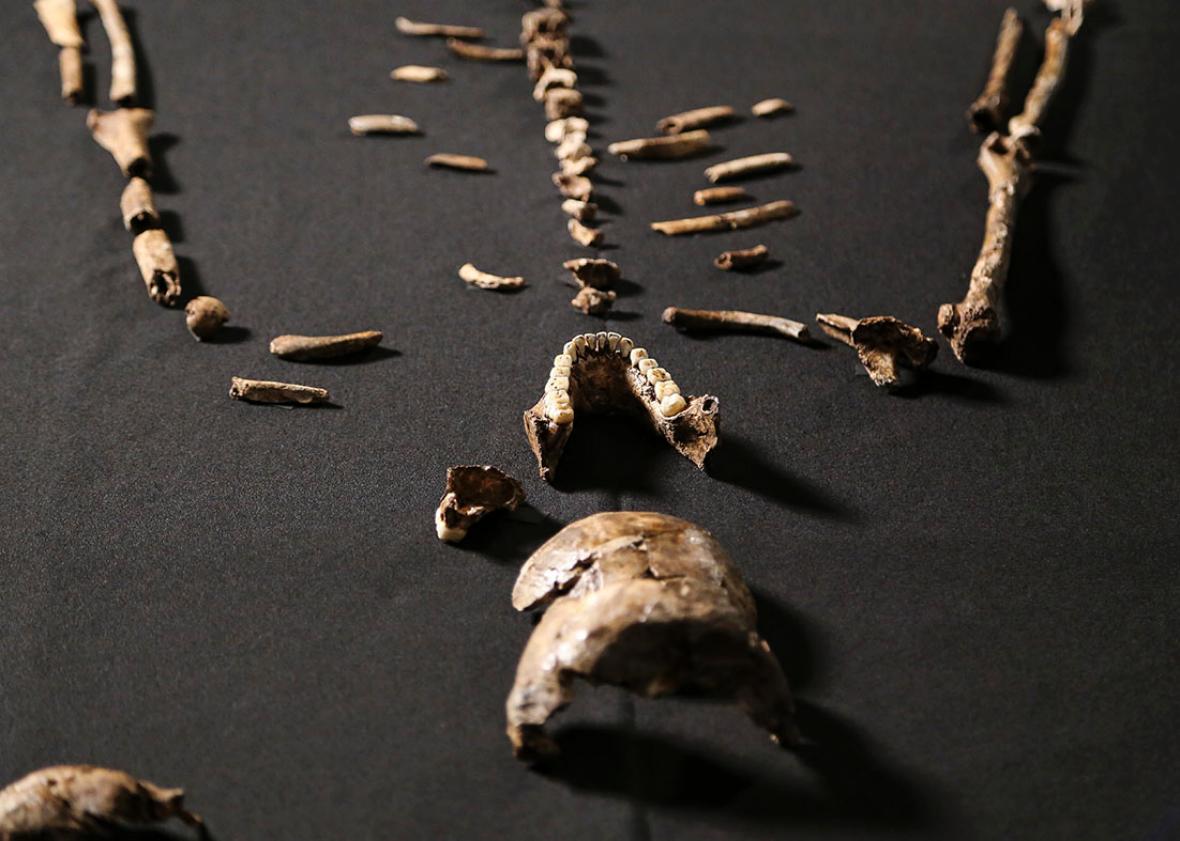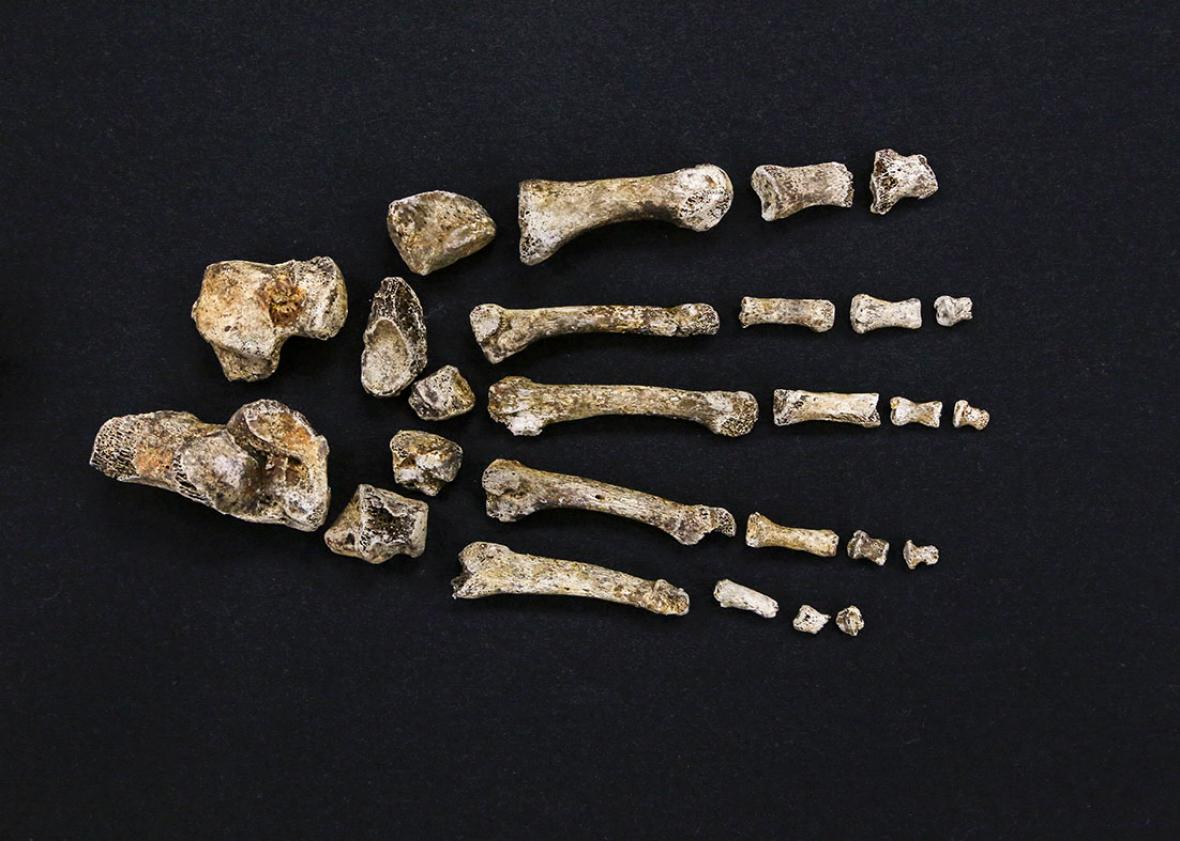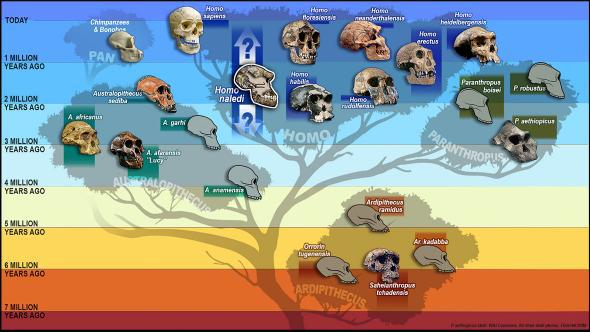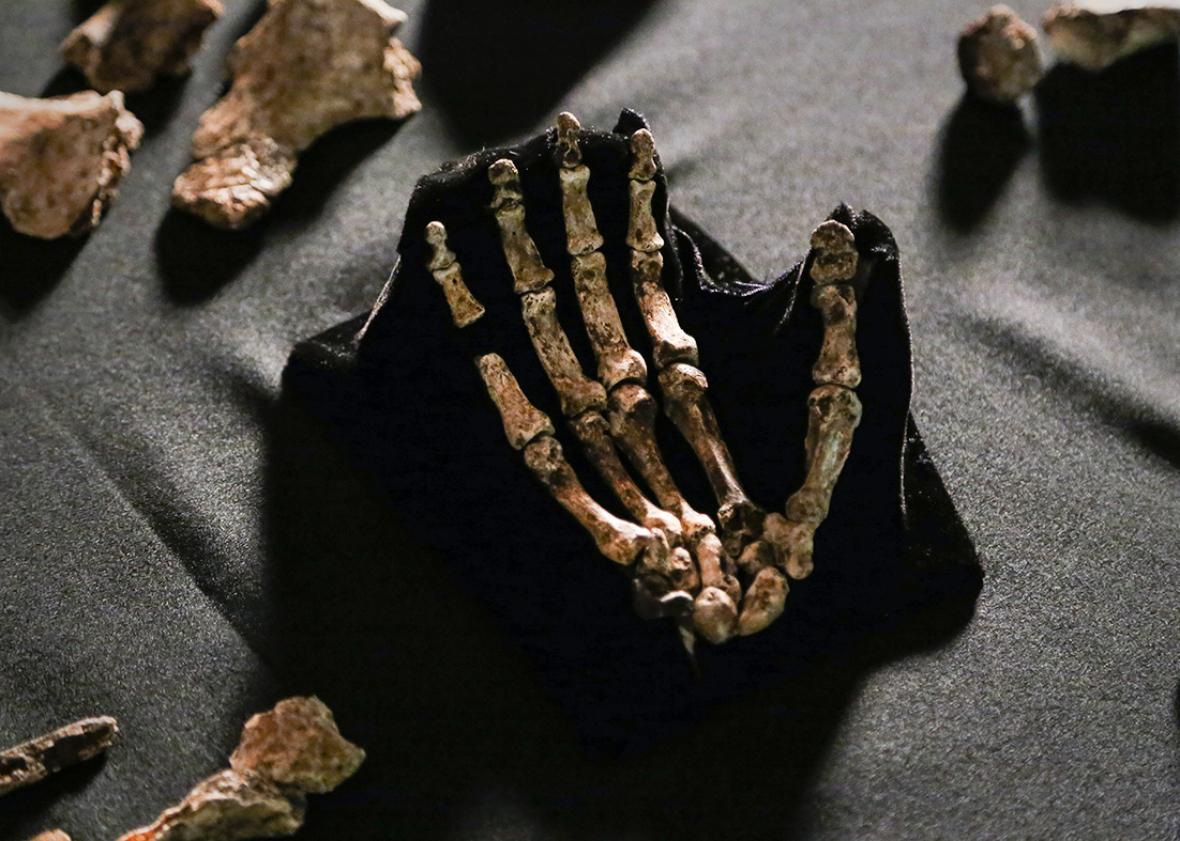A trio of cavers squeezed through a tiny chute in the Rising Star cave system in South Africa two years ago, emerged into a chamber, and spied a skull that appeared to be very, very old. Based on that discovery, paleoanthropologist Lee Berger and a team of scientists on Thursday introduced the world to Homo naledi, a strange new hominid species.
After the initial discovery, scientists excavated more than 1,500 fossil elements from at least 15 distinct individuals.
It’s lucky for Berger, of the University of the Witwatersrand in Johannesburg, and his team that they had such a remarkable sample size, and that the environment in which the fossils were found was isolated and pristine. Otherwise, it’s possible that no one would have believed them.
That’s because Homo naledi has slender arms and legs like modern humans; a small brain capacity akin to Homo erectus (which evolved about 2 million years ago); and hips, shoulders, and chests similar to Australopithecus (the genus that predates Homo and ranges in age from 4 million to 1.4 million years ago). Its wrists and palms, like its arms, are similar to ours. But it has an immensely powerful thumb.
It is, as Berger described it, “A Mr. Potato Head disaster.”
“None of that would fit,” he told me. “You wouldn’t want to put any of that into one object. Yet here it is. And it’s not just (as we’re sort of forced to be used to, typically) one specimen. We have 15 individuals, 1,500-plus elements. Almost every bone in the body represented multiple times, every age level from effectively fetal to the elderly, males and females.”
A sample size of that breadth and depth allowed Berger and his colleagues to classify Homo naledi (naledi means star in the Sesotho language and is a reference to the Rising Star cave system) as a whole new species, unusual as it is, without much controversy.
Homo naledi’s Frankenstein morphology might not be the most surprising thing to come out of Thursday’s announcement and series of papers published in the journal eLife, however. Researchers also concluded that the newfound species intentionally deposited its dead, a trait previously attributed only to Homo sapiens and our relatively large-brained cousins, Neanderthals and possibly Homo heidelbergensis.
“I think it’s going to take generations to get over that,” Berger said. “Even for us now. You’re faced with a remarkable situation of a small-brained primitive hominid that is almost certainly deliberately disposing of its dead in a sort of repeated ritualized fashion, in an underground chamber. That alone is remarkable. The fact is, it almost certainly would have been risky to get to this chamber. So they are not only secreting these bodies away to an area where nothing could get to them, they were taking risks in doing that. Only humans do that. Until this moment, we’ve never seen another form doing that, and we’d have never thought of something small-brained and primitive doing that.”
Everyone associated with the excavation project is careful to avoid the term burial, as it implies ceremony or ritual. But they ruled out seemingly every possibility other than the intentional secreting of the dead.

Photo by John Hawks/University of Wisconsin–Madison
“We knew it would be provocative,” said John Hawks, a paleontologist at the University of Wisconsin and one of the team leaders said. “We still fight about whether Neanderthal buried their dead. We had to test every alternative.”
Hawks patiently describes the various alternative explanations and why they don’t fit. If predators or scavengers were dragging bodies to the site, the fossils would show indications of toothmarks, broken bones, and disaggregated remains. If the cave were a trap, such as a hole that was easy to fall into, there would be other animals in it. But there are not. If there had been a flood, there would be sand and sediments.
“At a certain point, the logical explanation is that Homo naledi did this,” Hawks said. “That is a conclusion we arrived at cautiously and don’t overinterpret. We have to find out more.”
The Rising Star cave system is located within the Cradle of Humankind, a UNESCO World Heritage Site covering 180 square miles that has been the site of many important hominid discoveries. The Sterfonktein caves have yielded a 2.3 million–year-old Australopithecus africanus fossil discovered in 1947 known as Mrs. Ples and a nearly complete Australopithecus skeleton known as Little Foot, discovered in 1994. In 2008, at the Malapa cave site, Berger’s 9-year-old son found a clavicle belonging to an early hominid. Berger’s subsequent excavation yielded two partial skeletons, which came to be known as Australopithecus sediba.

Photo by John Hawks/University of Wisconsin–Madison
Those nearby sites had one important thing in common: The fossils were embedded in breccia, a sedimentary rock that allows for dating. Many of the sites also have fossils of extinct animals, which helps pin down the date. So while there is some debate as to how old the fossils are, scientists can at least hazard a guess. Not so with Homo naledi. The bones, found in what came to be called the Dinaledi Chamber, were lying open on the floor or encased in clay, which was removed with brushes. The same environment that preserved the bones has made it very difficult to date them.
“We know [Homo naledi] must come from relatively deep time, as it has many, many primitive characteristics,” Berger said. “Our analysis tells it must come from somewhere at the base of the genus Homo. So if our present understanding of the time frame of the genus Homo is right, then naledi must be somewhere older than 2 million years as a species, in its origins. That doesn’t mean the population we found is that old.”
Not only is this new species upending what we thought we knew about human evolution, the Rising Star expedition upended the way that paleoanthropologists do science.
For starters, the chamber is nearly inaccessible. The narrowest chokepoint is a mere 7 inches wide. After the cavers—Rick Hunter, Steve Tucker, and Pedro Boshoff—contacted Berger with their finding, Berger sent his son (yes, the same son who helped discover Australopithcus sediba) into the chamber with a camera, but Berger knew he himself couldn’t fit.
So Berger put out a call on Facebook for, essentially, skinny scientists with climbing or caving experience. That might have limited the pool of talent from which he could choose, but it led to a group with diverse experience. Within a few weeks, the team was assembled, and the first excavation took place in November 2013.
“It was an incredible experience to work with people from these incredible backgrounds,” said Alia Gurtov, a biological anthropology doctoral student at the University of Wisconsin who studies teeth and who spent three weeks in the chamber. The excavation team worked in two shifts of three, with two people always working on fossils and one operating a camera that transmitted video of what they were doing back to the scientists on the surface.
Gurtov described the painstaking processes that they had to go through to extract the fossils in cramped quarters. “In many cases, it took so long to remove a bone that all six of us would have worked on it at some point. I do especially fondly remember working on a piece of the brow ridge with Elen Feuerriegel. We were on either side of it. Bringing that out of the cave was a real moment of triumph, because I felt like that was the first time I’d seen the face of this hominin.”
When the project turned from excavation to analysis, Berger faced a new challenge. A cache of more than 1,500 fossils would take a team of experienced scientists decades to decipher. He had such a team in place, but there was just one problem. They were still busy working on Australopithecus sediba. By 2012, Berger’s team of 60 had produced dozens of papers about that new species.

Photo by John Hawks/University of Wisconsin–Madison
“They were already overworked,” he said. “We were already sitting with this tremendous richness of fossils, and everyone was snowed under working with that material. We needed to do something different.”
Once again, he put out a call to Facebook. In short order, he had a team of early-career scientists with a mix of nationalities and specialties headed to South Africa to work in partnership with more experienced scientists. Berger set up the analysis very carefully, with the fossils grouped by body part and the scientists separated. Depending on a scientists’ background, he or she might be working in Tooth Booth, Hand Land, or Hip Haven.
“They built these individual pictures in an uncontaminated way, so they weren’t biased by other areas of anatomy,” Berger said. “By the time they built an image, we allowed that natural communication with allied areas. So the foot people began to speak with the lower-limb people. The lower-limb people begin to work with the hip people, the hip people begin working with the thorax people. The upper-limb people with the shoulder people.”
That’s when things got interesting.

Illustration by S.V. Medaris/University of Wisconsin–Madison
Australopithecus species are very early hominids, dating back perhaps 4.4 million years. They are not the first branch off the evolutionary tree after our break with chimpanzees, but they are ancient. Some of the most famous hominids—including Lucy, discovered in Eastern Africa in 1974 and for many years the most complete early hominid skeleton on record—are Australopithecus. They were between 3½ and 5 feet tall, had brains one-third the size of modern humans, and were bipedal but considered to be capable climbers.
Homo erectus, one of the older known species in the Homo genus, was more land-based and built for walking, having shed some of the apelike qualities of its Australopithecus predecessors. But while its brain is larger than an Australopithecus, it’s still smaller than later Homo species.
Modern humans emerged about 200,000 years ago. We have slender skeletons, hands well-suited to tool-making, and large brains. We’ve lost the curved fingers, deep brow ridges and sloping foreheads of our ancestors. We are taller but less powerful.
And Homo naledi shares characteristics with all of those groups.
“People are coming in with experience, extensive experience, at looking at one part of the body,” Hawks explained. “We set them to work. ‘Here’s the leg bone. Go to work!’ … That’s what people train to do. They all get into their work so deeply. It gradually dawned on people, ‘I know what I’m working with here.’ But what they are telling me at this other group is totally different. Wait a minute, this doesn’t make any sense!”
The discovery of Homo naledi comes at an auspicious time for paleoanthropology. As recently as the turn of this (still very young) century, leading scientists posited that human evolution had followed a very linear path, that there was one dominant hominid species alive at any time. Today, the hominid family tree is blossoming and it’s becoming clear that different hominid species lived at the same time. Scientists have separated Australopithecus from its robust cousins boisei and robustus, who are now classified as genus Paranthropus. Naledi is the eighth Homo species to be identified.
And it is a species that defies expectations and easy classification. It will cause us to rethink much of what we thought we knew about human evolution. As Berger said, “it’s clear we have to prepare to be surprised.”
